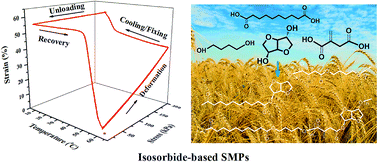Synthesis and characterization of biobased isosorbide-containing copolyesters as shape memory polymers for biomedical applications†
Abstract
Novel biobased isosorbide-containing copolyesters (PBISI copolyesters) with both biocompatibility and sustainability were synthesized by using commercially available biobased diols and diacids. Due to the presence of itaconate in copolyesters, it can be readily crosslinked by peroxide into a crystallizable network. The structure and thermal properties of PBISI copolyesters were determined by 1H NMR, FTIR, DSC, and WAXD. The chain composition, melting point and crystallinity of the PBISI copolyesters can be tuned continuously by changing the content of isosorbide. The crosslinked copolyester is demonstrated to be a promising shape memory polymer (SMP) with excellent shape memory properties including shape fixity and shape recovery rate close to 100%. The switching temperatures of PBISI-based SMPs can be tuned between 26 °C and 54 °C by altering the composition of PBISI copolyesters and curing extent. Cell adhesion and proliferation were adopted to evaluate the potential biocompatibility of PBISI-based SMPs, and the results indicated that all the PBISI-based SMPs were essentially noncytotoxic, making them suitable for fabricating biomedical devices.


 Please wait while we load your content...
Please wait while we load your content...